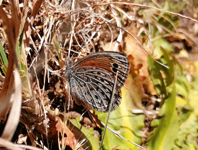Abstract
Ticks (Ixodida) are haematophagous arthropods that transmit a number of pathogenic organisms, including bacteria, protozoa and viruses, to humans and animals. Globally, there are over 900 species of ticks and Australia has 73 described species, including five introduced and 68 native species. With the exception of only a few Australian tick species, there are still many unanswered questions regarding their taxonomy and systematics, and the phylogeny of Australian ticks is not properly resolved. In recent years, a putative link between tick bites and poorly defined tick-borne illness(es) has been identified (Graves & Stenos 2017) and was the subject of a 2015 Australian Senate Inquiry into Lyme-like illnesses in Australia. There is an urgent need to further categorise Australian ticks, specifically hard ticks (Ixodidae), and accurate identification of Australian ticks is therefore of high importance.
References
Arthur, D.R. (1956) The Ixodes ticks of Chiroptera (Ixodoidea, Ixodidae). Journal of Parasitology, 42, 180–196.
https://doi.org/10.2307/3274734
Barker, S.C. & Walker, A.R. (2014) Ticks of Australia. The species that infest domestic animals and humans. Zootaxa, 1–144.
https://doi.org/10.11646/zootaxa.3816.1.1
Cao, X., Liu, J., Chen, J., Zheng, G., Kuntner, M. & Agnarsson, I. (2016) Rapid dissemination of taxonomic discoveries based on DNA barcoding and morphology. Scientific Reports, 6, 37066.
https://doi.org/10.1038/srep37066
De Queiroz, K. & Good, D.A. (1997) Phenetic clustering in biology: a critique. The Quarterly Review of Biology, 72, 4–27.
https://doi.org/10.1086/419656
Gofton, A.W., Doggett, S., Ratchford, A., Oskam, C.L., Paparini, A., Ryan, U. & Irwin, P. (2015) Bacterial Profiling Reveals Novel “Ca. Neoehrlichia”, Ehrlichia, and Anaplasma Species in Australian Human-Biting Ticks. PLoS One, 10, e0145449.
https://doi.org/10.1371/journal.pone.0145449
Graves, S.R. & Stenos, J. (2017) Tick-borne infectious diseases in Australia. Medical Journal of Australia, 206, 320–324.
https://doi.org/10.5694/mja17.00090
Guillemin, M.L., Contreras-Porcia, L., Ramirez, M.E., Macaya, E.C., Contador, C.B., Woods, H., Wyatt, C. & Brodie, J. (2016) The bladed Bangiales (Rhodophyta) of the South Eastern Pacific: Molecular species delimitation reveals extensive diversity. Molecular Phylogenetics and Evolution, 94, 814–826.
https://doi.org/10.1016/j.ympev.2015.09.027
Kearse, M., Moir, R., Wilson, A., Stones-Havas, S., Cheung, M., Sturrock, S., Buxton, S., Cooper, A., Markowitz, S., Duran, C., Thierer, T., Ashton, B., Meintjes, P. & Drummond, A. (2012) Geneious Basic: an integrated and extendable desktop software platform for the organization and analysis of sequence data. Bioinformatics, 28, 1647–1649.
https://doi.org/10.1093/bioinformatics/bts199
Kekkonen, M. & Hebert, P.D. (2014) DNA barcode-based delineation of putative species: efficient start for taxonomic workflows. Molecular Ecology Resources, 14, 706–715.
https://doi.org/10.1111/1755-0998.12233
Kwak, M.L., Beveridge, I., Koehler, A.V., Malipatil, M., Gasser, R.B. & Jabbar, A. (2017) Phylogenetic analysis of the Australasian paralysis ticks and their relatives (Ixodidae: Ixodes: Sternalixodes). Parasites and Vectors, 10, 122.
https://doi.org/10.1186/s13071-017-2045-4
Masters, B.C., Fan, V. & Ross, H.A. (2011) Species delimitation – a geneious plugin for the exploration of species boundaries. Molecular Ecology Resources, 11, 154–157.
https://doi.org/10.1111/j.1755-0998.2010.02896.x
Moon, K.L., Banks, S.C. & Fraser, C.I. (2015) Phylogeographic Structure in Penguin Ticks across an Ocean Basin Indicates Allopatric Divergence and Rare Trans-Oceanic Dispersal. PLoS One, 10, e0128514.
https://doi.org/10.1371/journal.pone.0128514
Puillandre, N., Lambert, A., Brouillet, S. & Achaz, G. (2012) ABGD, Automatic Barcode Gap Discovery for primary species delimitation. Molecular Ecology, 21, 1864–1877.
https://doi.org/10.1111/j.1365-294X.2011.05239.x
Roberts, F.H.S. (1962) On the status of morphologically divergent populations of Amblyomma triguttatum Koch (Acarina: Ixodidae). Australian Journal of Zoology, 10, 367–381.
https://doi.org/10.1071/ZO9620367
Roberts, F.H.S. (1970) Australian Ticks. Commonwealth Scientific and Industrial Research Organization, Melbourne, 267 pp.
Sakamoto, J.M., Goddard, J. & Rasgon, J.L. (2014) Population and demographic structure of Ixodes scapularis Say in the eastern United States. PLoS One, 9, e101389.
https://doi.org/10.1371/journal.pone.0101389
Song, S., Shao, R., Atwell, R., Barker, S. & Vankan, D. (2011) Phylogenetic and phylogeographic relationships in Ixodes holocyclus and Ixodes cornuatus (Acari: Ixodidae) inferred from COX1 and ITS2 sequences. International Journal of Parasitology, 41, 871–880.
https://doi.org/10.1016/j.ijpara.2011.03.008
Thompson, J.D., Higgins, D.G. & Gibson, T.J. (1994) Clustal-W - Improving the Sensitivity of Progressive Multiple Sequence Alignment through Sequence Weighting, Position-Specific Gap Penalties and Weight Matrix Choice. Nucleic Acids Research, 22, 4673–4680.
https://doi.org/10.1093/nar/22.22.4673
Yang, R., Murphy, C., Song, Y., Ng-Hublin, J., Estcourt, A., Hijjawi, N., Chalmers, R., Hadfield, S., Bath, A., Gordon, C. & Ryan, U. (2013) Specific and quantitative detection and identification of Cryptosporidium hominis and C. parvum in clinical and environmental samples. Experimental Parasitology, 135, 142–147.
https://doi.org/10.1016/j.exppara.2013.06.014

